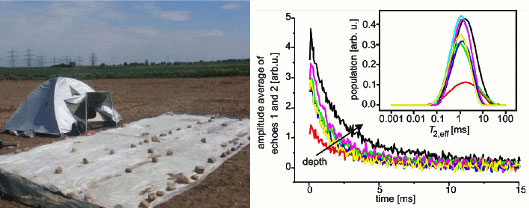continued as
 in Phase III
in Phase III
Pore structures, moisture, and water transport in soil by NMR




Research Area:
Hydrology, Geophysics, NMR logging, Physical Chemistry

This project aims at the characterization of soil structures, patterns and their influence on water transport in the vadose zone by means of low-field nuclear magnetic resonance (NMR). This non-invasive technique reveals the distribution and pore-scale transport of soil moisture, as well as NMR relaxation times, all of which were shown to empirically correlate with pore-scale soil texture on the one hand, and (centi)meter-scale soil hydraulics on the other hand. Thus, NMR soil-typing can not only help bridge the gap between pore-scale and macro-scale soil hydraulics empirically, but also, when combined with appropriate modeling, it holds the prospect of finding analytical solutions to many unanswered questions.
NMR soil-typing is primarily performed in laboratory environments using home-built NMR hardware, such as the NMR MOUSE, a single-sided sensor and profiler, and Halbach arrays for volumetric measurements. Here, one- and two-dimensional measurements facilitate modeling and simulations of pore-scale processes to derive advection and diffusion numbers, as well as kinetic exchange rates, which identify the underlying mechanisms of molecular motion. Moreover, specific pore-scale phenomena, such as preferential flow, stage-2 evaporation or drying fronts are assessed quantitatively by in-depth profiling.
The knowledge gained in the laboratory is currently applied in field experiments, employing the portable, home-built Slim Line NMR Logging Tool, to measure changes in water saturation and relaxation time distributions of genuine soils under the influence of natural precipitation or artificial irrigation. By correlating NMR results with data obtained by other measurement techniques, we plan to integrate our findings into the larger context of hydrogeology.
Cooperation partner:
Projects: A2, A3, B5
- Cropsense.net (BMBF funded)
- S.Stapf (Ilmenau)
- S. Oswald (Potsdam)
- M. Snehota (Prague)
- P. Galvosas (Wellington)
- A. Pines (UC Berkeley)
- J. Reimer (UC Berkeley)
- Rodolfo Acosta (Universidad Nacional de Córdoba)